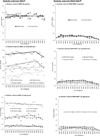Time Trends in Rates of Hodgkin Lymphoma Histologic Subtypes: True Incidence Changes or Evolving Diagnostic Practice?
- PMID: 26215294
- PMCID: PMC4592457
- DOI: 10.1158/1055-9965.EPI-15-0281
Time Trends in Rates of Hodgkin Lymphoma Histologic Subtypes: True Incidence Changes or Evolving Diagnostic Practice?
Abstract
Background: Histologic subtypes of classical Hodgkin lymphoma [cHL; e.g., nodular sclerosis, mixed cellularity, not otherwise specified (NOS)] are epidemiologically and prognostically distinctive. Therefore, unexplained, ongoing incidence rate declines for mixed cellularity and increases for NOS require examination.
Methods: We analyzed detailed histology-specific Hodgkin lymphoma incidence rates in 1992 through 2011 U.S. SEER data (n = 21,372) and reviewed a regional subset of 2007 through 2011 NOS pathology reports for insight into diagnostic practices.
Results: cHL rates were stable until 2007, then decreased for whites [annual percent change (APC) and 95% confidence interval (CI), -3.6% (-5.6% to -1.5%)]. Nodular sclerosis rates declined after 2007 by 5.9% annually, with variation by gender, age, and race/ethnicity. In 1992 through 2011, mixed cellularity rates declined [APC -4.0% (-4.7% to -3.3%)], whereas NOS rates rose [5.3% (4.5%-6.2%)] overall and in most patient groups. The 2007-2011 NOS age-specific rates were more similar to mixed cellularity rates for 1992-1996 than 2007-2011. Trends in combined rates were minimal, supporting increasing misclassification of mixed cellularity, lymphocyte depletion, and specific nodular sclerosis subtypes as NOS. Eighty-eight of 165 reviewed NOS pathology reports addressed classification choice. Twenty (12.1%) justified the classification, 21 (12.7%) described insufficient biopsy material, and coders missed specific subtype information for 27 (16.4%).
Conclusion: Recent nodular sclerosis rate declines largely represent true incidence changes. Long-term rate decreases for mixed cellularity and other less common subtypes, and increases for NOS (comprising ∼30% of cHL cases in 2011), likely reflect changes in diagnostic and/or classification practice.
Impact: Diminishing histologic subtyping undermines future surveillance and epidemiologic study of Hodgkin lymphoma. Guideline-based use of excisional biopsies and more coding quality control are warranted.
©2015 American Association for Cancer Research.
Conflict of interest statement
None of the coauthors has actual, potential, or perceived conflicts of interest related to this paper
Figures





References
-
- Caporaso NE, Goldin LR, Anderson WF, Landgren O. Current insight on trends, causes, and mechanisms of Hodgkin's lymphoma. Cancer Journal. 2009;15:117–123. - PubMed
-
- Eberle FC, Mani H, Jaffe ES. Histopathology of Hodgkin's lymphoma. Cancer Journal. 2009;15:129–137. - PubMed
-
- Kuppers R. The biology of Hodgkin's lymphoma. Nat Rev Cancer. 2009;9:15–27. - PubMed
Publication types
MeSH terms
Grants and funding
LinkOut - more resources
Full Text Sources
Medical

